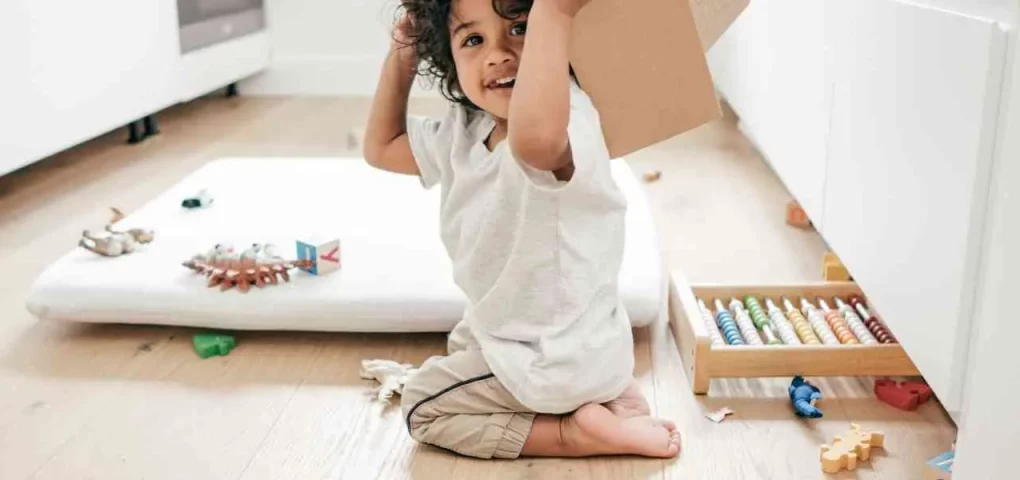
Children are naturally attached to the comfort of being around their parents. The security and warmth of a parent are cherished, but this disrupts their alone time together for most parents.
Sometimes parents need their private moments and conversations without their toddler’s bothering presence, which usually occurs while the child stays asleep.
Parents who have successfully mastered how to keep toddler in bed after falling asleep enjoy the most. In contrast, other parents go through site searches, wondering what they are doing wrong.
At the stage of moving from being a new baby in a crib to sleeping in a big-kid bed, toddlers are fond of getting out of bed at night and wandering into their parents’ room.
With their newfound freedom of movement at night, they will continue to do the same thing and desire to spend more time with their parents. Certain things must be done if you want to stop this habit.
Should a toddler fall asleep in their bed?

Some little kids are not ready to transition to a toddler bed, although the majority transition between the ages of 1.5 and 3.5 years. It can be scary thinking about how dangerous it can be if your toddler climbs out of their crib, don’t rush to buy a new bed the first time it happens.
Allowing your toddler to sleep in your bed while you lie next to them is not hard, but it shouldn’t be. They limit your sleep, and sometimes you might nod off early, which reduces your productivity.
It isn’t easy because you want your kid to sleep, but you also need sleep. They need to be comfortable in their beds.
If you know you cannot maintain the routine, it’s better to break it off before it becomes a habit and train your toddler to fall asleep themselves.
The transition for the sleeping routine should be gentle, and you should be ready to respond to any fear or doubt they might have to ensure they can overcome it and stay in bed.
3 reasons why they can't sleep
- Separation Anxiety
- No Bedtime Routine
- Wrong Medications
Methods of sleep training your toddler
It would have been awesome if one sleep training method worked for all toddlers in bed, but this isn’t a perfect world, so that is impossible.
Much like every other aspect of parenting, no single method works for every child. That’s why you will need to experiment to find out which works best for your child.
Sleep training a toddler has many names, including the word “walk” in them. That’s because you will be shuttling back and forth between your bed and your child’s room, probably all night.
Steps for sleep training a toddler:
- The normal toddler sleep routine should be completed. Also, include hugs and kisses.
- Leave quickly without so much of a fuss about it, and don’t give into answering last-minute pleas or requests.
- When your kid gets out of bed, walk them back calmly, tuck them in again and remind them that they need to stay in bed. Then leave the room.
- If your kids get out of bed again, calmly and quietly walk them back to bed, tuck them in, and leave the room.
- Repeat the steps.
It’s not easy to get your kids to stay in their beds for one or two hours, not to mention overnight. It might work on the first night or take longer, but it would work in a few weeks.
Remaining calm and quiet in the face of whatever your toddler throws at you is the key. This could also include them throwing things at you. Make sure to always stay calm and quiet.
When in need of motivation, think about the peaceful nights of conversation when it’s just you and your partner in bed, or you are sharing a bottle of wine with a family member.
Benefits of an alarm clock
- Teaches kids to be self-sufficient and independent at night.
- Helps to set out expectations.
- Helps with the routine and structure
There are rational reasons for a kid not to want to go to bed. Staying up is more fun than laying still, and there is a fear of missing out on the entertaining things parents or siblings do at night.
Sadly, they also drastically miscalculate their ability to be healthy and pleasant without getting enough sleep, so they must get back to bed.
What might seem like an impossible challenge is an opportunity to solidify your child with the tools to stay in bed and make them comfortable by knowing that it is a safe place.
Soon they will get comfortable and sleep through the night. Within a blink of an eye, your child has reached teenage years, and you will be on a search for strategies on how to get them out of bed.
9 Tips on How to Keep Toddler in Bed
1. Make it an achievement and bedtime routine

Introducing something to a child is all about mindset and the theme created around the event. When you make it a great success for your child to sleep independently, they become more welcoming to the activity.
The reward system is also a good way to get your toddler interested in sleeping alone. When they’re given a gift or a token for falling asleep in their bed all night, they become more proactive in getting the reward, which makes accomplishing the task easier with time.
Creating a toddler sleep routine where your toddler can get comfortable before going to bed can help keep them in their bed longer.
These routines include a bedtime story before bed or having a shower before bed. A visual bedtime sticker chart would have images of what your toddler does at bedtime in the same order every night.
Toddlers usually wake up at night 2-6 times. So it’s best to see bedtime as an opportunity for the toddler to learn and develop skills necessary to meet some of their sleep problems at night and self soothe themselves until they fall asleep.
2. Create a calm environment

Making sure children go to bed and stay asleep can be tricky. For at least 30 minutes before sleep time, make sure to create a calm environment for your toddler. Try reading a book till they are feeling tired.
Also, consider simple additions in your toddler’s room like pictures of family members, warm lighting, and a stuffed animal. It will convey a sense of home, and the toddler will fall asleep in no time.
3. Limit consumption before bedtime

Sugary sweets or other forms of sweets shouldn’t be consumed. The sugar rush that comes after can cause sleep issues, which can lead to a delay in bedtime because they would not be able to fall asleep.
When toddlers consume sugar, it increases their blood sugar levels and drops them significantly. It will take a while for the blood sugar levels to re-stabilize in such a small body, which will release stress hormones and adrenaline resulting in the child feeling restless.
4. Keep the room dark at night

In a dark room, your toddler is less stimulated, which helps to keep them calm and settled. A dark room also signals to your child that it is time to fall asleep. Shower them and after brushing teeth, make them comfortable.
Once your toddler can fall asleep in their own bed, they’ll sleep better in bed all night if there is no change in the amount of light in the room while they are asleep.
5. Get rid of distractions
Children love distractions, and their interest keeps getting fed. It can be challenging to get an excited toddler to stay in bed after bedtime while being in a room with people, food, and toys.
Make sure that there’s peace in the house. If the room is close to where the TV is, keep the volume low because it is only a matter of time before they get out of bed to explore.
6. Don't skip naps
Some kids don’t need naps, while for others, it’s important. It depends on your child. For toddlers aged 1-3 years, try to fit in one or two hours’ nap every day.
A skipped nap could lead to your children throwing tantrums and feeling irritable all day, which can make bedtime challenging for you. They will find other distractions rather than stay in bed.
If your toddler doesn’t need a nap, it’s best to have an early bedtime. The ideal number of hours for a toddler to sleep is usually between 12 and 14 hours. So if they skip one nap, then make sure they get the required hours of sleep during the night.
7. Providing comfort during nightmares

If a child wakes while having night terrors and runs to sleep in your bed overnight, then it’s okay to provide a haven for them under your covers. You can leave the door open to make the toddler feel safe. However, once they have their bearings and feel calmer, they should be placed back in their bed.
Try surrounding them with various reminders of comfort to make them feel safe and loved. The key is teaching kids how to be comfortable and independent in and out of bed.
8. Be active during the day

During the day, let your toddler let off some steam by being active outdoors. If indoors, ensure that the necessary precautions have been carried out, like installing a baby gate to protect the toddler from dangerous zones. Some parents have no issues with their toddler staying outside their own bed in the bedroom, so using a baby gate to keep the child contained might work.
The toddler might associate with the gate once a habit of falling asleep by it is established.
This can help release some stress-inducing hormones which can keep children up at night.
9. Fading method

Suppose you have a child accustomed to being rocked to sleep. In that case, you might want to consider a fading method usually suited for babies. Try transitioning him from a lap sleeper to a bed sleeper. Once tired and drowsy, gently place your child in the crib. Then leave.
Your child might wake up and start crying, wait a couple of minutes, then re-enter the room to comfort the toddler. Rub their back until they calm down, then leave them again.
Repeat the process if the toddler cries again. Continue this process until your child falls asleep.
What is Sleep Apnea

Sleep apnea is a sleep disorder in which breathing repeatedly stops and starts. Obstructive sleep apnea (OSA) breaks sleeps. It can cause the body’s oxygen levels to fall or the body’s carbon dioxide levels to rise. It often occurs because of a blockage in the airway.
This mostly occurs due to the narrowing of the upper airways. The child’s sleep pattern will be irregular.
Try to set time intervals on your alarm clock to check on the well-being of your toddler. You can stay awake all night long, but eventually, you might feel wiped out.
You can regulate your sleep or get assistance from a family member or friend if you don’t have a partner.
Giving toddlers melatonin
Our bodies produce melatonin, a natural sleep-inducing hormone. It can be hard to stay in bed as a kid and even harder to get out of bed as a parent.
Melatonin can be a short-term solution to help get toddlers to rest while sorting out your bedtime sticker chart. It also works for older kids in their teens to guarantee they are well-rested.
Melatonin is not approved or FDA-regulated for use as a sleep aid. Ensure to discuss with your pediatrician before using it.
Three things to know about melatonin
- It might make you wake up.
- There are some side effects.
- There is no right dosage (see an expert).
Big kid bed

Yes, it takes a lot of work, time, and patience to take care of a toddler. All the years of his early days with you having to wake up in the middle of the night and sulk through your to-do list in the morning will eventually pay off. Those toddler sleep problems will soon be history. Eventually, they grow up from a baby to a big boy and a great sleeper.
———-
Enjoyed this article? Share it with the other mommas out there too! And don’t forget to check out our other posts on the blog.


Leave a Reply